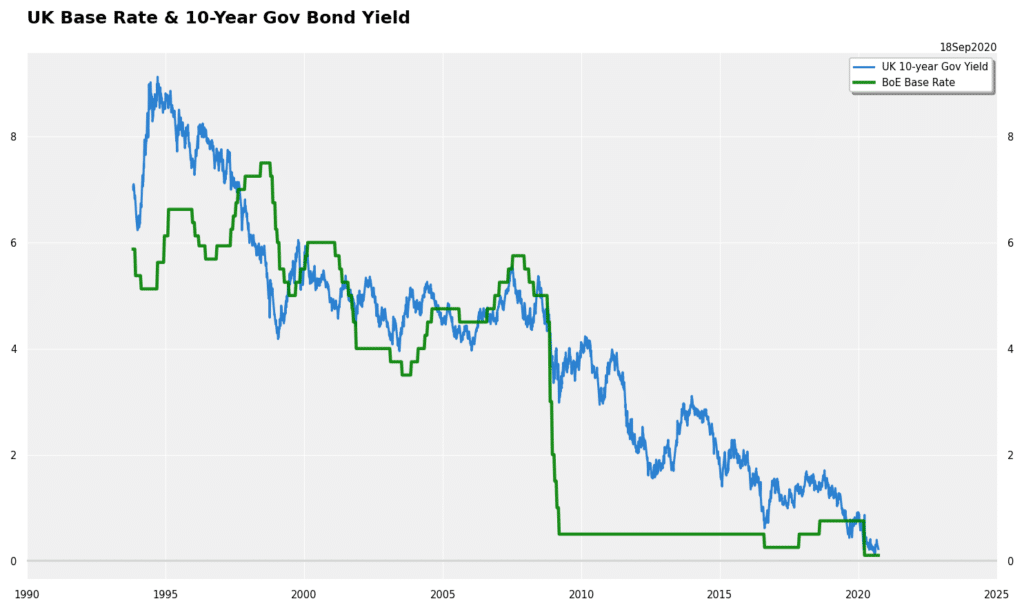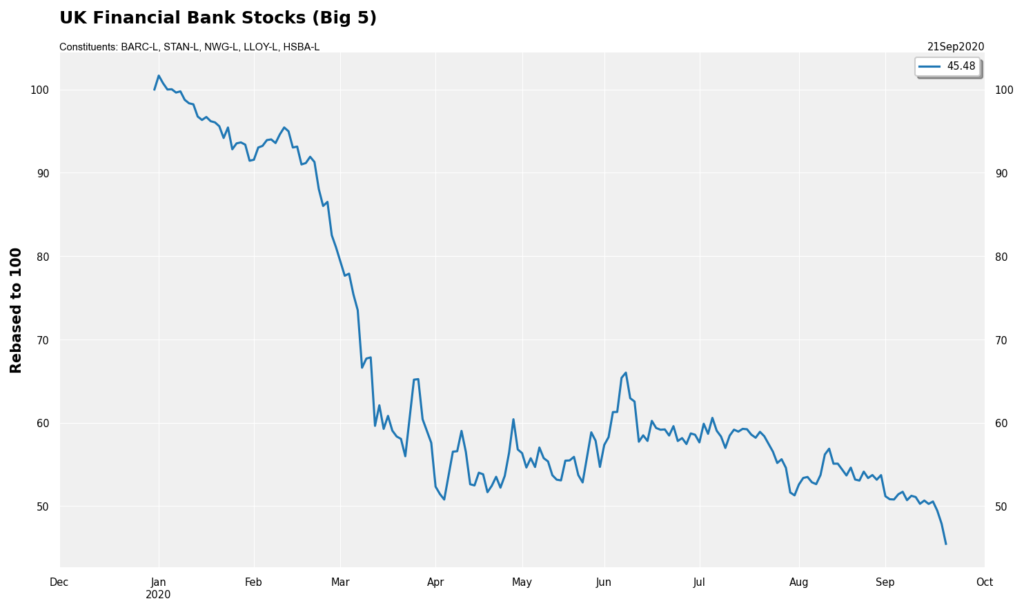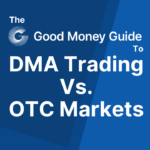As the Bank of England explores negative rates as UK economy weakens how will it impact your investments in the stock market?
Interest rate cycles straddle generations. In the last upswing, the Bank of England base rate peaked at 17% on 1980. For the next four decades, that borrowing cost went nowhere but down. The forty-year bear trend was only punctuated with occasional sharp, but brief, climbs.
Related Guide: How to invest in bonds and gilts
When the full force of the covid-19 pandemic struck the economy in March this year, it broke the base rate again. So worried was the nine-member Monetary Policy Committee (MPC) that they slammed the rate twice that month. First on March 11, 2020, then on March 19. The policy base rate started the year at a measly 0.75 per cent, now it lumbers on at a mere 0.10 per cent (see below). As the pandemic’s dreaded second wave lurks at the front door, gravity is re-exerting across the entire yield curve.

Source: Bank of England
Will UK borrowing costs swing into negative territories?
It is not unprecedented elsewhere. In May this year, amidst the heat of the first covid wave, the UK gov issued bonds that were negative yielding. In particular, the Debt Management Office sold £3.8bn gilts at -0.003 per cent. Investors who hold these bonds until maturity will see a thin sliver of capital sliced away.
When the economic outlook took a dive recently, the MPC, according to its September Report, began “to explore how a negative Bank Rate could be implemented effectively, should the outlook for inflation and output warrant it at some point during this period of low equilibrium rates.”
This is just exploration work. ‘It would be a cardinal sin,’ explained Andrew Bailey, the Bank of England governor, ‘if we stated had a tool in the box, which in practice we didn’t think we could operationally use…So it is no surprise we’re going to do this work.’ But this does not stop the flurry of speculation in the City that the UK is staring at negative rate territory in the near future.
Negative rates punish savers
How will this impact the wider society? For one, savers can no longer compound capital with interest. In fact, negative rates will slowly erode the original stake, either through banking fees or deposits charges. View another way, depositors will be paying banks to park their money.
More interestingly, will mortgage rates flip into negative areas? Not yet – for now. By and large, the UK mortgage curve is still positive. But in this age of extreme financial turbulence, the possibility of negative mortgage rates is not to be discounted, especially as the UK economy is under the twin assault of covid-19 and Brexit. When mortgage rates are negative, it means lenders are paying borrowers. In practice, however, lenders often protect themselves with clauses that stipulate a rate ‘floor’ that disregards the base rate after a certain level. In Europe, negative mortgage rates often result in faster reduction of outstanding debt. Practice like that may emerge in the UK. A mortgagor can hope.
Negative rates: Good for bonds, bad for banks?
For investors, a new world is emerging. Bonds and tech stocks are soaring while ‘old economy’ stocks are sagging. Banks, in particularly, are struggling in a negative-rate world. Their earnings are crushed by the ability to earn through the rapidly thinning spread between deposit and lending rates. A credit crisis is potentially brewing. No wonder investors are fleeing the sector.
In the chart below I traced the share movement of the Big 5 UK banks, Barclays (BARC), Standard Chartered (STAN), HSBC (HSBA), Lloyds (LLOY) and Natwest Group (NWG) since the start of the year. I averaged the returns across this group and rebased their returns to 100 on Jan 1, 2020.

Related Guide: How to profit from shorting shares
The trend is steadfastly bearish. Prices were sinking into new year lows even before the second wave hits the economy. HSBC and Standard Chartered, in particular, are plunging to new multi-decade lows. So negative is the industry’s outlook that one Nvidia (NVDA), currently pursuing ARM plc for $40bn, is worth more than twice the total market capitalisation of the Big 5 UK banks (data as of Sep 22, 2020). Mr Market certainly likes the tech sector better.
Nvidia (NVDA) Market Cap $312bn
UK Big 5 Banks Market Cap $143 bn
(HSBC-£58.85bn, LLOY-£17.19bn, BARC-£15.96bn, NWG-£11.70bn, STAN-£10.93bn)
From a contrarian point of view, however, the UK banks could be worth looking at if their share prices fall some more. But again, we could be staring at a generational bear market in banks. Interest rates are likely to stay suppressed in the near future. Any bargain hunting in this sector should be done with this in mind.

Jackson is a core part of the editorial team at GoodMoneyGuide.com.
With over 15 years industry experience as a financial analyst, he brings a wealth of knowledge and expertise to our content and readers.
Previously Jackson was the director of Stockcube Research as Head of Investors Intelligence. This pivotal role involved providing market timing advice and research to some of the world’s largest institutions and hedge funds.
Jackson brings a huge amount of expertise in areas as diverse as global macroeconomic investment strategy, statistical backtesting, asset allocation, and cross-asset research.
Jackson has a PhD in Finance from Durham University and has authored nearly 200 articles for GoodMoneyGuide.com.
You can contact Jackson at jackson@goodmoneyguide.com




